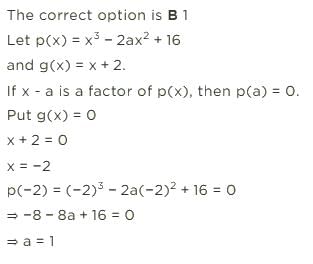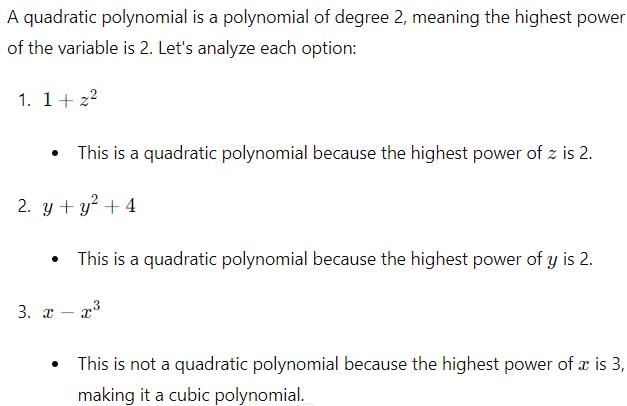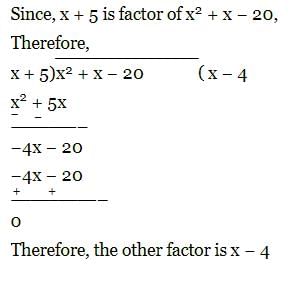Grade 9 Exam > Grade 9 Tests > Test: Introduction To Polynomials - Grade 9 MCQ
Test: Introduction To Polynomials - Grade 9 MCQ
Test Description
15 Questions MCQ Test - Test: Introduction To Polynomials
Test: Introduction To Polynomials for Grade 9 2025 is part of Grade 9 preparation. The Test: Introduction To Polynomials questions and answers have been prepared
according to the Grade 9 exam syllabus.The Test: Introduction To Polynomials MCQs are made for Grade 9 2025 Exam.
Find important definitions, questions, notes, meanings, examples, exercises, MCQs and online tests for Test: Introduction To Polynomials below.
Solutions of Test: Introduction To Polynomials questions in English are available as part of our course for Grade 9 & Test: Introduction To Polynomials solutions in
Hindi for Grade 9 course.
Download more important topics, notes, lectures and mock test series for Grade 9 Exam by signing up for free. Attempt Test: Introduction To Polynomials | 15 questions in 20 minutes | Mock test for Grade 9 preparation | Free important questions MCQ to study for Grade 9 Exam | Download free PDF with solutions
Test: Introduction To Polynomials - Question 1
If x + 2 is a factor of x3 – 2ax2 + 16, then value of a is
Detailed Solution for Test: Introduction To Polynomials - Question 1
Detailed Solution for Test: Introduction To Polynomials - Question 2
Test: Introduction To Polynomials - Question 3
What is the solution to the quadratic equation x² + 7x + 12 = 0?
Detailed Solution for Test: Introduction To Polynomials - Question 3
Test: Introduction To Polynomials - Question 4
If 3 + 5 – 8 = 0, then the value of (3)3 + (5)3 – (8)3 is
Detailed Solution for Test: Introduction To Polynomials - Question 4
Detailed Solution for Test: Introduction To Polynomials - Question 5
Test: Introduction To Polynomials - Question 6
Which of the following is not a quadratic polynomial?
Detailed Solution for Test: Introduction To Polynomials - Question 6
Test: Introduction To Polynomials - Question 7
P of x = ax, a is not equal to 0. find zeros of polynmial
Detailed Solution for Test: Introduction To Polynomials - Question 7
Detailed Solution for Test: Introduction To Polynomials - Question 8
Detailed Solution for Test: Introduction To Polynomials - Question 9
Test: Introduction To Polynomials - Question 10
If one of the factor of x2 + x – 20 is (x + 5). Find the other
Detailed Solution for Test: Introduction To Polynomials - Question 10
Test: Introduction To Polynomials - Question 11
A cubic polynomial is a polynomial of degree …………
Detailed Solution for Test: Introduction To Polynomials - Question 11
Test: Introduction To Polynomials - Question 12
Find the value of the polynomial 6 – 4x + 3x2 at x = 3
Detailed Solution for Test: Introduction To Polynomials - Question 12
Detailed Solution for Test: Introduction To Polynomials - Question 13
Detailed Solution for Test: Introduction To Polynomials - Question 14
Test: Introduction To Polynomials - Question 15
The degree of the polynomial x4 – 3x3 + 2x2 – 5x + 3 is:
Detailed Solution for Test: Introduction To Polynomials - Question 15
Information about Test: Introduction To Polynomials Page
In this test you can find the Exam questions for Test: Introduction To Polynomials solved & explained in the simplest way possible.
Besides giving Questions and answers for Test: Introduction To Polynomials, EduRev gives you an ample number of Online tests for practice
Download as PDF







 An equation involving a cubic polynomial is called a cubic equation. A closed-form solution known as the cubic formula exists for the solutions of an arbitrary cubic equation.
An equation involving a cubic polynomial is called a cubic equation. A closed-form solution known as the cubic formula exists for the solutions of an arbitrary cubic equation.










